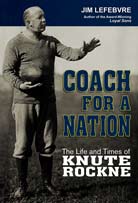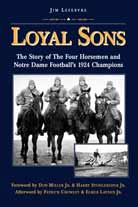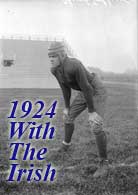Here is an interview with Jim Lefebvre, author of “Loyal Sons: The Story of The Four Horsemen and Notre Dame Football’s 1924 Champions”
Q How were you drawn to write about college football history?
JL Well, I was born and raised in a town known a little for the pro game – Green Bay, Wisconsin – but always have had a love for that special feeling you get on Saturdays in the fall…that there’s something very special taking place across the country. I listened to Wisconsin games on the radio, watched whatever game was shown on TV, and, like millions across the country, never missed Lindsey Nelson and the Notre Dame highlights on Sunday. The Packer game would be icing on the cake of an already-great weekend.
Q Did you play football yourself?
JL Only at the neighborhood level. I was, you might say, the player-coach-manager of our neighborhood team, “signing” players and making or accepting challenges of games from other “teams.” There were no adults involved, and maybe that’s why it’s such a fond memory today. As for more organized ball, our grade school did not have a team, and my high school (Our Lady of Premontre) was a football powerhouse. I’m afraid someone with my lack of skills and experience wouldn’t have last long. But I’m kind of sorry I didn’t at least try.
Q So you began writing?
JL Yes, my sports writing career started in high school. I’d cover our high school games, such as hockey, and walk my report down to the local paper. They would use a sentence or two of my “report” and I’d be delighted. My writing continued through college and onto newspapers in Madison and Milwaukee. Since then, my career has included stints as a magazine editor, specialty-editions publisher and in corporate communications. “Loyal Sons” is my first book.
Q What got you interested in The Four Horsemen?
JL Well, to go back to Green Bay for a moment, I attended the same Catholic grade school, St. John the Evangelist, that Jim Crowley had a half-century earlier. Spent a lot of time in the same neighborhood. And my dad and uncle had only been a few years behind Crowley at East High School. I heard the stories of “town team” football, of Curly Lambeau going off to Notre Dame and returning to found the Packers, and how he coached Crowley at East and sent him off to Notre Dame. I always wanted to know more about Crowley and his time at Notre Dame.
Q What did you find out about him?
JL Well that’s the thing – I found out that nobody had ever written a book specifically about The Four Horsemen or the 1924 season, when they led ND to its first national championship. For all the fame of the team, and the iconic photograph of the Four Horsemen, there was no such book.
Q Really?
JL Most people find it hard to believe, as I did. I went looking in the Notre Dame Bookstore in 2003, when my oldest daughter was getting ready to enter ND. I asked about The Four Horsemen, and was told, ‘Well, there’s their picture on the cover of that book’ or ‘Here’s something about the Horsemen.’ But it was always just a chapter in a book, or a retelling of the 1924 Army game. After a while, it became clear that nobody had ever done the research and put together the story of who these four were, what shaped them, how they got to Notre Dame and what their years were like there. Not to mention their teammates, the Seven Mules, the Shock Troops, or the whole atmosphere of the 1924 team.
Q How long did it take you to do the research?
JL It took about five years total, the final two years nearly full-time. I found and interviewed relatives of all 11 regulars on the 1924 team, along with relatives of another dozen or more players and coaches. To a person, they were cooperative and encouraging. They shared details of their families’ lives in greater deptch than could be used is such a wide-ranging story. Mostly, their response was, ‘Nobody’s ever asked that much about our Dad/Grandad/Uncle. They were happy that his story was being told.
Q Were the Four Horsemen famous mostly because of their nickname and picture?
JL Certainly, there is no disputing that Grantand Rice’s famous opening to his account of the 1924 Notre Dame-Army game, in which he christens the Irish backfield “the Four Horsemen,” and the subsequent publicity photo of the four posed on work horses, helped establish their fame. But I believe the story would have ended pretty quickly had the team lost a game along the way. Instead, they recorded one victory after another, against some of the best teams in the country, and some by staggering margins for that era. The 1924 Irish were called “Rockne’s Wonder Team” by sportswriters and fans across the country. By the time of the Jan. 1, 1925 Rose Bowl, they were clearly established as the dominant team of the year, and one of the best ever.
Q Hadn’t Notre Dame already been established as a national power?
JL Well, they had had a number of excellent seasons, both under Rockne and his predecessor Jess Harper. Rockne’s teams of 1919 and 1920, featuring the great George Gipp, were undefeated. But none played the schedule that the 1924 Irish did, and none were consensus national champs before the ’24 squad. Among other things, the 1924 Irish were the first football team of any kind to play games in New York City, Chicago and the Los Angeles area in the same season.
Q Were there other aspects that made 1924 special?
JL Many. Chicago’s WGN radio broadcast two Notre Dame games, the home game vs. Nebraska and the game against Northwestern at the “new Grant Park stadium,” The latter was the first major football game played at what we now know as Soldier Field. The Rose Bowl, of course, was Notre Dame’s first appearance in a bowl game – and last for another 45 years. The radio broadcast of the game, sent by repeater stations across the country, is considered the first truly national broadcast of a sports event in the U.S.
Q What was most different about the game of football as played in 1924?
JL A number of things. First, it was one-platoon football… your eleven best players played both offense and defense, with substitution limited by rule. You could not re-enter the game in the same quarter you came out. That’s what made Rockne’s use of the “shock troops” a major advance, and a precursor of two—platoon football. Second, in my opinion, was the importance of field position. Possessing the ball in your own end of the field was always cause to extreme caution. Often, deep in their own territory, teams would punt on first or second down, to get the ball out of the “danger zone.” And kickoff strategy was interesting. After any score, the team that was trailing would determine whether it wanted to kick off or receive the kickoff. Today, we’d say, of course we want the ball. Back then, more often than not, the choice was made to kick off, then try to pin your opponent deep in their end, and quite likely receive a punt near midfield. A third item would be the relatively flimsy “protective” equipment worn at the time.
Q You mentioned the “shock troops.” Can you explain what they were?
JL Sure. It was strictly a Rockne innovation. He started most games in 1924 with a full unit of second-string players. They might play a few series, they sometimes would play the entire first quarter. They had good size, and the idea was to absorb the opponents’ best shot, when their energy was highest. The regular 11 were on the sideline with Rockne, watching intently the plays and strategy of the opposition. It was a great psychological advantage for Notre Dame, when the rested regulars would come into the game against the partially worn-down regulars from the opposition.
Q Wasn’t Rockne also an ardent proponent of the forward pass?
JL I would say he used the forward pass judiciously. The offense wasn’t built around it, but when used, it was often when least expected. Other teams passed mostly when it a desperate situaton. Notre Dame set up the pass with a variety of other plays. There were numerous fakes and feints. The backfield was undersized, even for the day, with Layden the biggest at about 162 pounds. They wouldn’t have held up well using “power football” or “mass football” popular in that time.
Q So were the Four Horsemen mostly rushers?
JL The thing about the four is that they were all skilled in a variety of ways. On any given play, any of them might rush, drop back to pass, or receive a pass. The Notre Dame shift put them nearly into motion at the center snap, which could go to any one of the four. It was that versatility — combined with their speed, deception and precision — that made them nearly unstoppable at times. Defenses simply couldn’t key on one individual, and very rarely could they guess where the next play was going.
Q What about the Seven Mules? What was their role?
JL The front line was also on the smaller side, so they also used a number of finesse moves, rather than simply one-on-one straight-ahead blocking. Adam Walsh at center was the captain, and in many ways, the heart and soul of the team. An incredible two-way player, he went into the 1924 Army with one broken hand, and on the third play of the game, suffered broken bones in the other one. He put on one of the greatest displays of defensive football in history, accounting for the lion’s share of ND’s tackles, along with a game-saving interception.
Q And he is not nearly as famous as the Four Horsemen?
JL That’s one of the things, if I may say so, that makes “Loyal Sons” a intersting read. We’ve gone far beyond what most people know about this team and this season.






